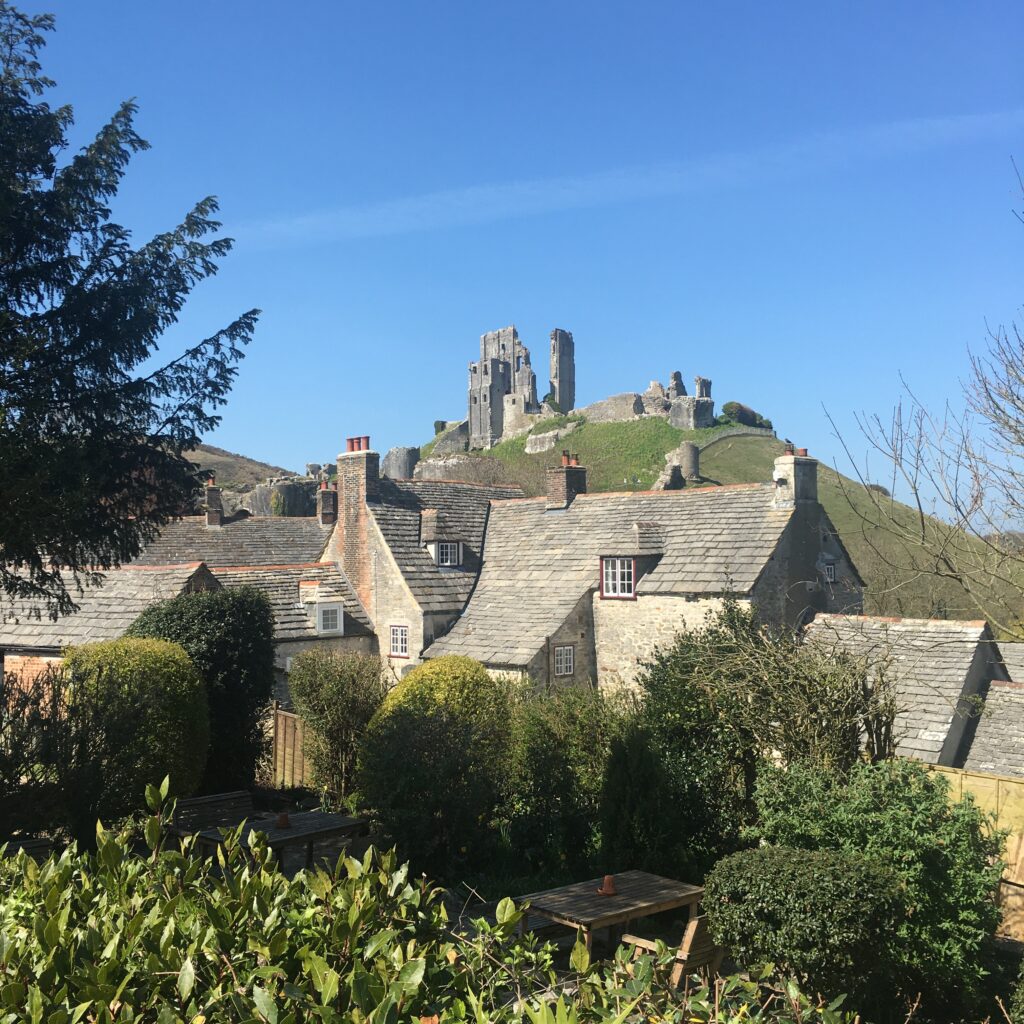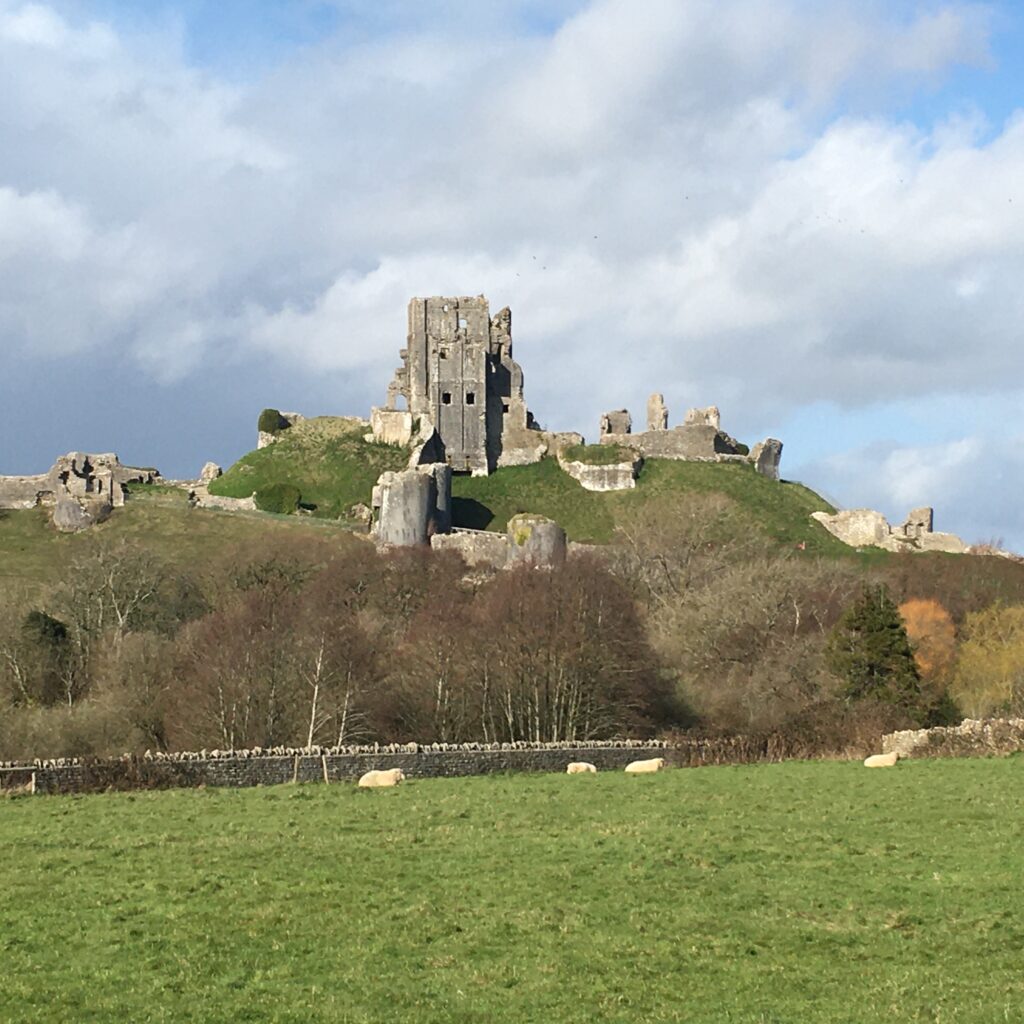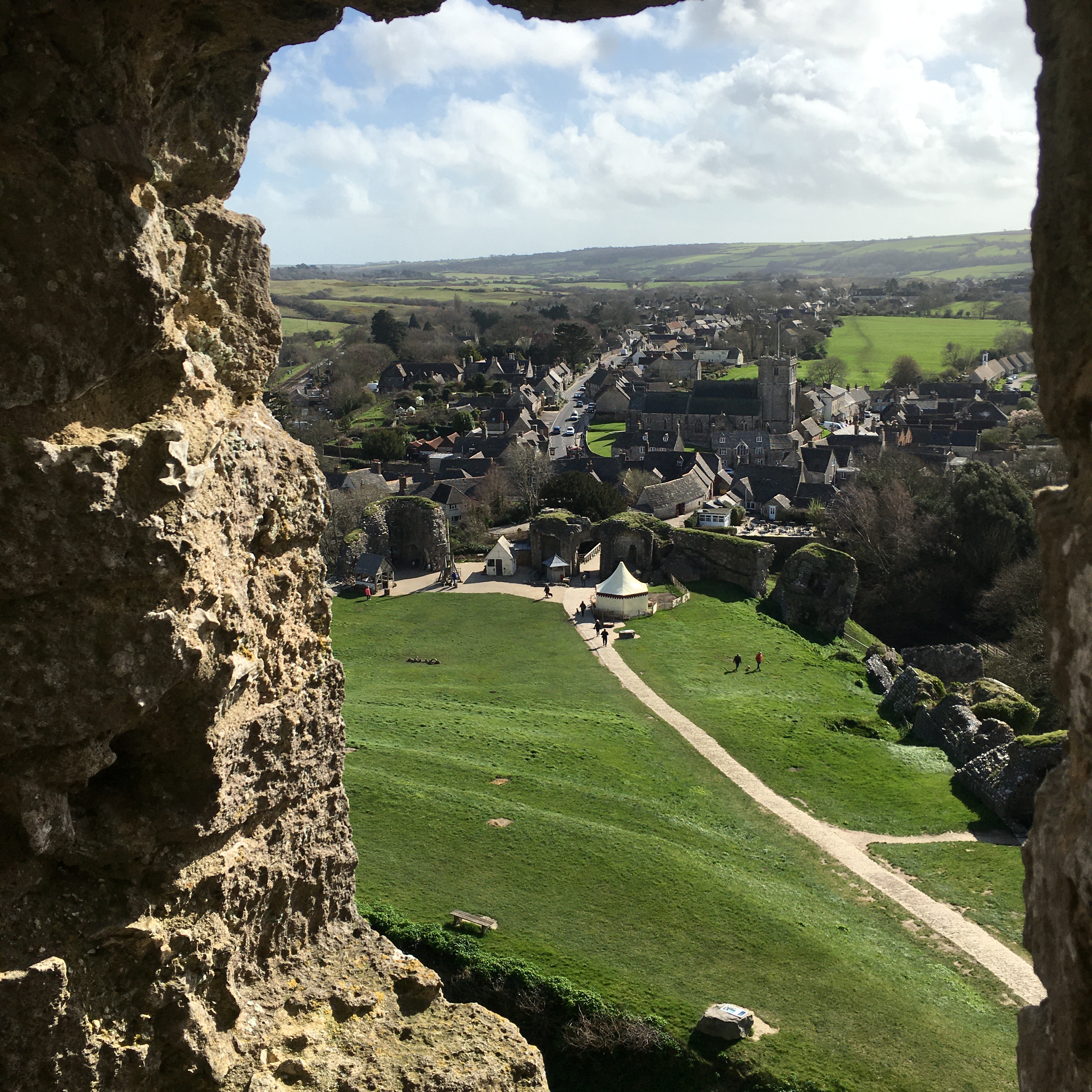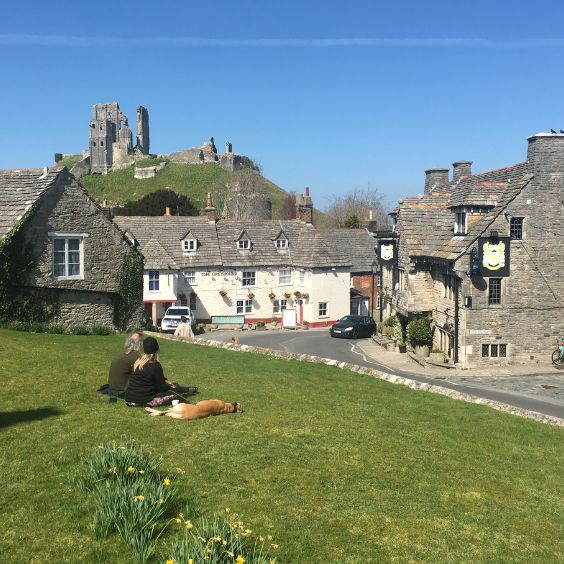The majestic, medieval Corfe Castle near our Dorset B&B has remained an impressive part of the Purbeck landscape for nearly 1000 years.
 Corfe Castle near our Dorset B&B – The Beginning
Corfe Castle near our Dorset B&B – The Beginning
William the Conqueror ordered the castle to be built in 1086.
The mound on which it was built was natural. Before the castle was ordered to be built, a timber Saxon Hall was positioned on top.
Many craftspeople were needed for such a vast construction and as a result, the village of Corfe was formed.
The castle took almost 200 years to be built. The amount of Purbeck stone used to build the castle is thought to be about half a million tons. The stone came from the quarries at Langton and Worth Matravers.
The quarry men were very proud and went to work in their best clothes changing just before they went underground.
Corfe Castle near our Dorset B&B was designed to be impressive, and it certainly was. Standing 21m tall and on top of a 55m high mound, the castle could be seen from all around.
By 1285 the castle was finally complete which included a drawbridge and portcullis. It was one of the most important buildings in England, both historically and architecturally.
From when it was first ordered to be built in 1086 until 1572, it was under the ownership of the royal family until Queen Elizabeth 1 sold it into private hands.
In the early 17th Century, it was owned by Lady Elizabeth Hatton and the castle was a high-status household. When Sir John Bankes, The Lord Chief Justice, bought it in 1635 it was in immaculate condition. History books reveal that the interior was filled with beautiful tapestries and furniture.
 Gruesome and Ghostly Happenings
Gruesome and Ghostly Happenings
Although impressive, the castle has witnessed its fair share of gruesome and ghostly happenings.
On the mound even before the castle was built, legend has it that in 978, the young 15-year-old Saxon King, Edward the Martyr, was on his way to Saxon Hall to visit his half-brother and stepmother when he was tragically intercepted by assassins and stabbed in the back on the site of what is now the second gatehouse at Corfe Castle. He was the victim of his stepmother who wanted her own son Ethelred the Unready to rule the throne.
Edward the Martyr was initially buried in The Church of Lady Saint Mary in Wareham. His remains were removed shortly afterwards and reburied at Shaftesbury Abbey. If you would like to read more about the Saxon market town of Wareham, please refer to our blog ‘Saxon Walls of Wareham’.
In medieval times, prisoners at the castle were locked in an underground dungeon and left to starve in their own waste, including the Anglo-Welsh noblewoman Margaret de Braose and her son William. On discovering the bodies, apparently the mother had actually started to gnaw into the cheek of her son.
During undermining of the South West Gatehouse in 1646, the miners had to run for their lives when the structure began to fall. People have since spoken of hearing cries for help, when walking through the gatehouse.
In terms of castle ghosts, a headless woman in white has been known to stalk the walls within the castle ruins since 1645. She has approached visitors only to turn away and disappear!
Some people have felt a tap on the shoulder; on looking around they found no-one was there.
Apparently whilst the National Trust have been on digs in the castle, they can feel someone watching them; and they all look up at the same time!



 ‘Brave Dame Mary’ and the Collapse of Corfe Castle
‘Brave Dame Mary’ and the Collapse of Corfe Castle
In 1646 Corfe Castle sadly became a ruin.
It was during the Civil War in England between 1642 -1651 that Royalists and Parliamentarians clashed over the manner of England’s governance and issues of religious freedom.
Sir John Bankes, who owned Corfe Castle at the time and was the crown’s closest advisor, sided with the Royalists. Whilst he was working away with King Charles 1, the castle was left in the capable hands of his wife Lady Mary Bankes.
In May 1643, Lady Mary Bankes and her daughters were warned of the Parliamentarians approaching the castle. Bravely Lady Mary Bankes ordered her soldiers to secure the castle. The Parliamentarians told her to give up the castle defence, to which she didn’t.
In June 1643, the castle was under siege, as well as houses in the village, which were burnt and ransacked. Large lumps of stone and hot embers were showered down on the Parliamentarians to prevent them from gaining entrance.
The Parliamentarians were also known as Roundheads because of the way their hair was cut.
Unfortunately, in 1644 Sir John Bankes died of fever. Lady Mary Bankes was deeply saddened but determined to take a stand and fight on for king and country.
She defiantly fought on until February 1646 when an officer in the garrison, Lt Colonel Pitman, betrayed her. He tricked her by bringing in Parliamentarian soldiers, disguised as royalists, in the middle of the night. A few hours later it was all over.
The following month in March 1646 despite Lady Mary Bankes’ tireless petition and bravery, the House of Commons finally voted to demolish the castle.
In testament to her bravery, Lady Mary Bankes, ‘Brave Dame Mary’, was allowed to the seals and keys of the castle.
The keys can be seen at Kingston Lacy near Wimborne, which was built in 1663-5 for Sir Ralph Bankes, son of Lady Mary Bankes and Sir John Bankes, to replace their existing home at Corfe Castle.
To read more about about Kingston Lacy, please refer to our blog ‘Kingston Lacy belonging to the National Trust.’
 Who Owns the Castle Today?
Who Owns the Castle Today?
Corfe Castle remained in the hands of the Bankes family until 1981, when ancestor H.J.R Bankes, before his death, spoke to the National Trust about leaving the Kingston Lacy and Corfe Castle Estate to them. Of course, his bequest included the ancient monument of Corfe Castle itself.
Proudly, his bequest was gratefully accepted by The National Trust and ever since it has been sensitively cared for by them!
Throughout the year the castle attracts thousands of visitors from all over the world, some of which stay with us at Spurwing! It really is a magical place to visit, and the views from the top are spectacular.
If you would like to visit Corfe Castle, which we highly recommend, please refer to ‘Where to park on your visit to Corfe Castle’ below.
You can also find further information regarding opening times, events etc at the castle on the Corfe Castle website.
 Where to park on your visit to Corfe Castle near our Dorset B&B
Where to park on your visit to Corfe Castle near our Dorset B&B
Corfe Castle National Trust Car Park (BH20 5DR)
As you drive towards Swanage on the A351 from our Dorset B&B, the mound which the castle sits on towers above you to your right. On the left is a National Trust Car Park and an informative Visitor Centre.
To get to the castle entrance from here, cross over the road and follow the signposted trail beside Corfe River for a lovely scenic walk to the castle. It’s a 10-minute walk from the car park to the village square and to the castle entrance.
Purbeck Park, Norden (BH20 5DW)
If you are planning on spending all day at Corfe Castle or using Corfe as a base and taking the steam train to Swanage, then it may be cheaper and more convenient to park just outside of the village at Purbeck Park at Norden. Purbeck Park is a large car park. You can catch the train from the Purbeck Park (Norden Station) or easily walk into Corfe Castle which takes about 20 minutes.
West Street Car Park (BH20 5HH)
This car park is not recommended during the summer months and holiday period due to congestion, however at other times of the year this council-run car park is just off West Street in Corfe Castle village. Access to this car park is right through the middle of the village square.
If you enjoyed reading this blog and would like to learn about updates, events in the area or last-minute availability at our Dorset B&B, Spurwing Guest House, you can subscribe to our mailing list: https://eepurl.com/gWilmz









